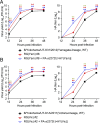Development of high-yield influenza B virus vaccine viruses
- PMID: 27930325
- PMCID: PMC5187690
- DOI: 10.1073/pnas.1616530113
Development of high-yield influenza B virus vaccine viruses
Abstract
The burden of human infections with influenza A and B viruses is substantial, and the impact of influenza B virus infections can exceed that of influenza A virus infections in some seasons. Over the past few decades, viruses of two influenza B virus lineages (Victoria and Yamagata) have circulated in humans, and both lineages are now represented in influenza vaccines, as recommended by the World Health Organization. Influenza B virus vaccines for humans have been available for more than half a century, yet no systematic efforts have been undertaken to develop high-yield candidates. Therefore, we screened virus libraries possessing random mutations in the six "internal" influenza B viral RNA segments [i.e., those not encoding the major viral antigens, hemagglutinin (HA) and neuraminidase NA)] for mutants that confer efficient replication. Candidate viruses that supported high yield in cell culture were tested with the HA and NA genes of eight different viruses of the Victoria and Yamagata lineages. We identified combinations of mutations that increased the titers of candidate vaccine viruses in mammalian cells used for human influenza vaccine virus propagation and in embryonated chicken eggs, the most common propagation system for influenza viruses. These influenza B virus vaccine backbones can be used for improved vaccine virus production.
Keywords: Victoria lineage; Yamagata lineage; high-yield; influenza B virus; vaccine.
Conflict of interest statement
Y.K. has received speaker’s honoraria from Toyama Chemical and Astellas Inc.; grant support from Chugai Pharmaceuticals, Daiichi Sankyo Pharmaceutical, Toyama Chemical, Tauns Laboratories, Inc., and Otsuka Pharmaceutical Co., Ltd.; and is a founder of FluGen. G.N. is a founder of FluGen.
Figures







References
-
- van de Sandt CE, Bodewes R, Rimmelzwaan GF, de Vries RD. Influenza B viruses: Not to be discounted. Future Microbiol. 2015;10(9):1447–1465. - PubMed
-
- Rota PA, et al. Cocirculation of two distinct evolutionary lineages of influenza type B virus since 1983. Virology. 1990;175(1):59–68. - PubMed
-
- Belshe RB. The need for quadrivalent vaccine against seasonal influenza. Vaccine. 2010;28(Suppl 4):D45–D53. - PubMed
Publication types
MeSH terms
Substances
Grants and funding
LinkOut - more resources
Full Text Sources
Other Literature Sources
Medical
Miscellaneous

